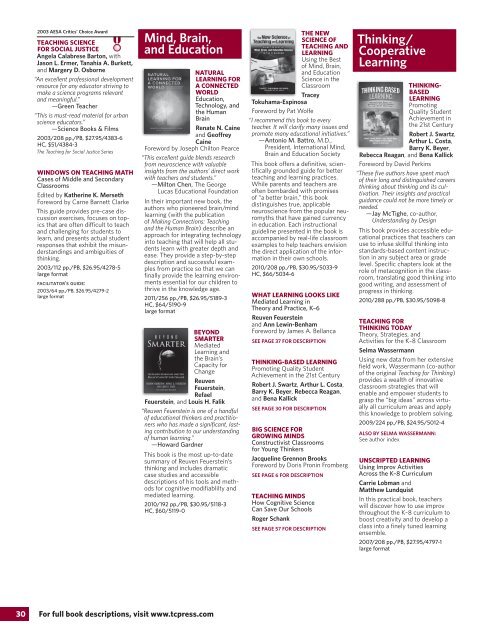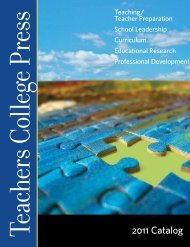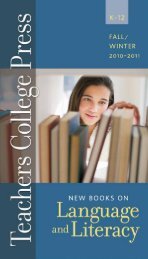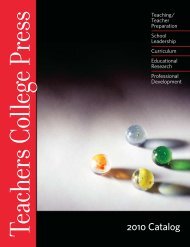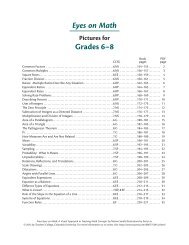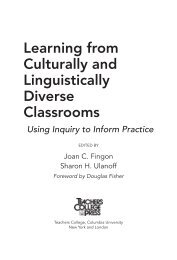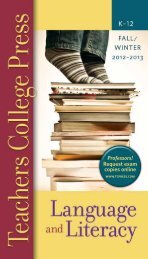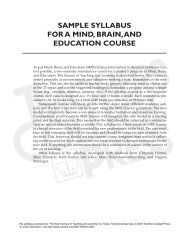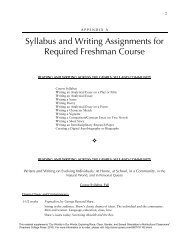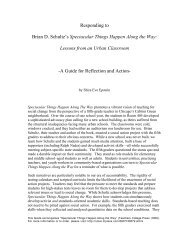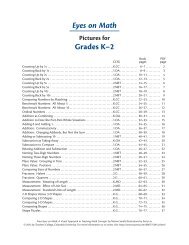estsellers - Teachers College Press
estsellers - Teachers College Press
estsellers - Teachers College Press
Create successful ePaper yourself
Turn your PDF publications into a flip-book with our unique Google optimized e-Paper software.
2003 AESA Critics’ Choice Award<br />
Teaching Science<br />
for Social Justice<br />
Angela Calabrese Barton, with<br />
Jason L. Ermer, Tanahia A. Burkett,<br />
and Margery D. Osborne<br />
“An excellent professional development<br />
resource for any educator striving to<br />
make a science programs relevant<br />
and meaningful.”<br />
—Green Teacher<br />
“This is must-read material for urban<br />
science educators.”<br />
—Science Books & Films<br />
2003/208 pp./PB, $27.95/4383-6<br />
HC, $51/4384-3<br />
The Teaching for Social Justice Series<br />
Windows on Teaching Math<br />
Cases of Middle and Secondary<br />
Classrooms<br />
Edited by Katherine K. Merseth<br />
Foreword by Carne Barnett Clarke<br />
This guide provides pre-case discussion<br />
exercises, focuses on topics<br />
that are often difficult to teach<br />
and challenging for students to<br />
learn, and presents actual student<br />
responses that exhibit the misunderstandings<br />
and ambiguities of<br />
thinking.<br />
2003/112 pp./PB, $26.95/4278-5<br />
large format<br />
facilitator’s guide:<br />
2003/64 pp./PB, $26.95/4279-2<br />
large format<br />
Mind, Brain,<br />
and Education<br />
Natural<br />
Learning for<br />
a Connected<br />
World<br />
Education,<br />
Technology, and<br />
the Human<br />
Brain<br />
Renate N. Caine<br />
and Geoffrey<br />
Caine<br />
Foreword by Joseph Chilton Pearce<br />
“This excellent guide blends research<br />
from neuroscience with valuable<br />
insights from the authors’ direct work<br />
with teachers and students.”<br />
—Milton Chen, The George<br />
Lucas Educational Foundation<br />
In their important new book, the<br />
authors who pioneered brain/mind<br />
learning (with the publication<br />
of Making Connections: Teaching<br />
and the Human Brain) describe an<br />
approach for integrating technology<br />
into teaching that will help all students<br />
learn with greater depth and<br />
ease. They provide a step-by-step<br />
description and successful examples<br />
from practice so that we can<br />
finally provide the learning environments<br />
essential for our children to<br />
thrive in the knowledge age.<br />
2011/256 pp./PB, $26.95/5189-3<br />
HC, $64/5190-9<br />
large format<br />
Beyond<br />
Smarter<br />
Mediated<br />
Learning and<br />
the Brain’s<br />
Capacity for<br />
Change<br />
Reuven<br />
Feuerstein,<br />
Refael<br />
Feuerstein, and Louis H. Falik<br />
“Reuven Feuerstein is one of a handful<br />
of educational thinkers and practitioners<br />
who has made a significant, lasting<br />
contribution to our understanding<br />
of human learning.”<br />
—Howard Gardner<br />
This book is the most up-to-date<br />
summary of Reuven Feuerstein’s<br />
thinking and includes dramatic<br />
case studies and accessible<br />
descriptions of his tools and methods<br />
for cognitive modifiablilty and<br />
mediated learning.<br />
2010/192 pp./PB, $30.95/5118-3<br />
HC, $60/5119-0<br />
The New<br />
Science of<br />
Teaching and<br />
Learning<br />
Using the Best<br />
of Mind, Brain,<br />
and Education<br />
Science in the<br />
Classroom<br />
Tracey<br />
Tokuhama-Espinosa<br />
Foreword by Pat Wolfe<br />
“I recommend this book to every<br />
teacher. It will clarify many issues and<br />
promote many educational initiatives.”<br />
—Antonio M. Battro, M.D.,<br />
President, International Mind,<br />
Brain and Education Society<br />
This book offers a definitive, scientifically<br />
grounded guide for better<br />
teaching and learning practices.<br />
While parents and teachers are<br />
often bombarded with promises<br />
of “a better brain,” this book<br />
distinguishes true, applicable<br />
neuroscience from the popular neuromyths<br />
that have gained currency<br />
in education. Each instructional<br />
guideline presented in the book is<br />
accompanied by real-life classroom<br />
examples to help teachers envision<br />
the direct application of the information<br />
in their own schools.<br />
2010/208 pp./PB, $30.95/5033-9<br />
HC, $66/5034-6<br />
What Learning Looks Like<br />
Mediated Learning in<br />
Theory and Practice, K–6<br />
Reuven Feuerstein<br />
and Ann Lewin-Benham<br />
Foreword by James A. Bellanca<br />
See page 37 for description<br />
Thinking-Based Learning<br />
Promoting Quality Student<br />
Achievement in the 21st Century<br />
Robert J. Swartz, Arthur L. Costa,<br />
Barry K. Beyer, Rebecca Reagan,<br />
and Bena Kallick<br />
See page 30 for description<br />
Big Science for<br />
Growing Minds<br />
Constructivist Classrooms<br />
for Young Thinkers<br />
Jacqueline Grennon Brooks<br />
Foreword by Doris Pronin Fromberg<br />
See page 6 for description<br />
Teaching Minds<br />
How Cognitive Science<br />
Can Save Our Schools<br />
Roger Schank<br />
See page 57 for description<br />
Thinking/<br />
Cooperative<br />
Learning<br />
Thinking-<br />
Based<br />
Learning<br />
Promoting<br />
Quality Student<br />
Achievement in<br />
the 21st Century<br />
Robert J. Swartz,<br />
Arthur L. Costa,<br />
Barry K. Beyer,<br />
Rebecca Reagan, and Bena Kallick<br />
Foreword by David Perkins<br />
“These five authors have spent much<br />
of their long and distinguished careers<br />
thinking about thinking and its cultivation.<br />
Their insights and practical<br />
guidance could not be more timely or<br />
needed.<br />
—Jay McTighe, co-author,<br />
Understanding by Design<br />
This book provides accessible educational<br />
practices that teachers can<br />
use to infuse skillful thinking into<br />
standards-based content instruction<br />
in any subject area or grade<br />
level. Specific chapters look at the<br />
role of metacognition in the classroom,<br />
translating good thinking into<br />
good writing, and assessment of<br />
progress in thinking.<br />
2010/288 pp./PB, $30.95/5098-8<br />
Teaching for<br />
Thinking Today<br />
Theory, Strategies, and<br />
Activities for the K–8 Classroom<br />
Selma Wassermann<br />
Using new data from her extensive<br />
field work, Wassermann (co-author<br />
of the original Teaching for Thinking)<br />
provides a wealth of innovative<br />
classroom strategies that will<br />
enable and empower students to<br />
grasp the “big ideas” across virtually<br />
all curriculum areas and apply<br />
this knowledge to problem solving.<br />
2009/224 pp./PB, $24.95/5012-4<br />
Also by Selma Wassermann:<br />
See author index<br />
Unscripted Learning<br />
Using Improv Activities<br />
Across the K–8 Curriculum<br />
Carrie Lobman and<br />
Matthew Lundquist<br />
In this practical book, teachers<br />
will discover how to use improv<br />
throughout the K–8 curriculum to<br />
boost creativity and to develop a<br />
class into a finely tuned learning<br />
ensemble.<br />
2007/208 pp./PB, $27.95/4797-1<br />
large format<br />
30<br />
For full book descriptions, visit www.tcpress.com


